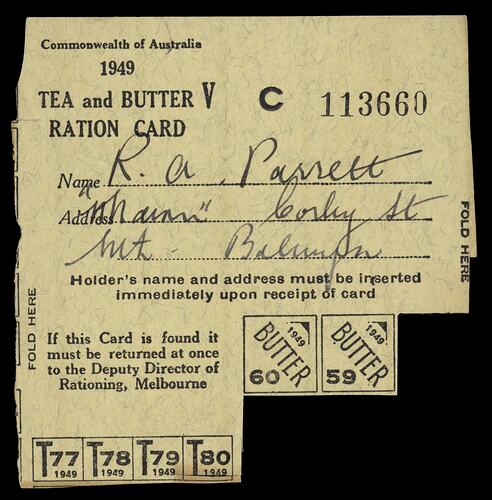Summary
Brown cardboard ration card dated 1949 for tea and butter, issued to R.A. Parrett of Balwyn North.
Shortages of foodstuffs, clothing and other products were part of life on the homefront during World War II. The first controls over the production and distribution of products were introduced in 1940, partly due to disruption of shipping. In 1942, after Japan entered the War, comprehensive rationing was introduced to manage shortages and control civilian consumption. The first product to be rationed was clothing, gazetted in June 1942. Tea rationing was introduced a month later on 6 July 1942, with an initial allowance of one pound (about 500 grams) per five weeks per adult. Butter rationing was introduced on 7 June 1943, allowing one pound per fortnight. Sugar and meat were also rationed. After the War, rationing was gradually phased out. The last rationed products were butter, ending June 1950, and tea, ending July 1950.
Physical Description
Brown cardboard ration card dated 1949 for tea and butter. Upper 2/3rd contains handwritten text in black ink. The rest of the text is printed in black ink. Only two butter coupons left and several tea coupons.
Significance
Historic context: By early 1942, World War II was no longer a distant conflict for Melburnians. Japanese forces were advancing in the Pacific, and Australia's northern coastline was being bombed. In Melbourne, anti-aircraft guns were installed at Maribyrnong, and by mid-1942, 30 000 American troops were stationed in the city. Regulations clamped down on everyday life, controlling where people worked and what food, clothes and petrol they could buy. Even the number of football games and race meetings were restricted. Melbourne's factories ramped up production - especially those making munitions, aeroplanes, textiles and food. Because labour was scarce, women worked in new areas such as heavy industry and public transport. The war changed the economic, industrial and cultural landscape of Melbourne forever. (Melbourne Story exhibition label, 2008)
More Information
-
Collecting Areas
-
Acquisition Information
Donation from Mr Robert Parrett, 29 Jun 1989
-
Publisher
Commonwealth of Australia, Melbourne, Greater Melbourne, Victoria, Australia, 1949
-
Issued To
R. A. Parrett, Corby Street, North Balwyn, Greater Melbourne, Victoria, Australia, 1949-1950
-
Inscriptions
Printed: Commonwealth of Australia/1949 TEA and BUTTER V/ RATION CARD/C 113660/Name: R.A. Parrett/Address: Corby St/Nth Balwyn/Holder's name and address must be inserted immediatly upon receipt of card. If this Card is found it/must be returned at once to the Deputy Director of Rationing, Melbourne.
-
Classification
-
Category
-
Discipline
-
Type of item
-
Overall Dimensions
8.4 cm (Width), 8.7 cm (Height)
-
References
'Rationing of food and clothing during the Second World War', National War Memorial, [Link 1] accessed 30/1/2009 Departmental history of rationing of clothing and food, 1942-1950 (Melbourne: Commonwealth Rationing Commission, 1950) S.J. Butlin and C.B. Schedvin, War economy, 1942-1945, Australia in the War of 1939-45, vol. IV, (Canberra: Australian War Memorial, 1977): pp. 286-309
[Book] Darian-Smith, Kate. 1990. On the home front: Melbourne in wartime 1939-1945.
-
Keywords
Home Fronts, Ration Coupons, Rationing, Wars & Conflicts, World War II, 1939-1945



